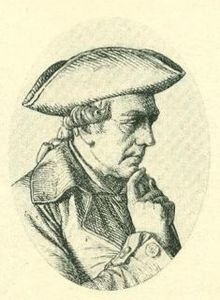Caspar Frederik Harsdorff
| Caspar Frederik Harsdorff | |
|---|---|
 |
|
| Born |
26 May 1735 Copenhagen, Denmark |
| Died | 24 May 1799 (aged 63) Copenhagen, Denmark |
| Nationality | Danish |
| Alma mater | Royal Danish Academy of Fine Arts |
| Occupation | Architect |
| Buildings | Harsdorff House |
Caspar Frederik (Friedrich) Harsdorff, also known as C.F. Harsdorff, (26 May 1735 – 24 May 1799), Danish neoclassical architect is considered to be Denmark’s leading architect in the late 18th century, and is referred to as “The Father of Danish Classicism”.
He was born Caspar Frederik Harsdørffer in Copenhagen, Denmark to German-born schoolteacher Johan Christopher Harsdørffer from Nürnberg and his Swedish-born wife Anne Marie Eriksdatter.
He began his education in mathematics in order to train for the Engineer Corps, but his interest lay in architecture, which he studied enthusiastically. When the Royal Danish Academy of Art (Det Kongelige Danske Kunstakademi) opened in 1754 at Charlottenborg Palace he was able to study under French architect Nicolas-Henri Jardin.
In 1756 his design for a city gate won the Academy’s large gold medallion, giving him the distinction of being the first Danish architect to win the coveted award. The award included a six-year travel grant.
He traveled to Paris 1757, and he stayed there four years, also in the company of painter Jens Pedersen Lund and sculptor Carl Frederik Stanley who resided in Paris at the same time as Harsdorff. While there he studied diligently under Jacques-François Blondel, an architect to Louis XV of France.
In late spring 1762 he traveled to Rome, where he discovered the remains of Ancient Rome, and he understood that his education until then had been incomplete. While in Italy he drew and measured the antiquities he studied.
He returned to Denmark in 1764, and was named Building Inspector. That same year he was invited to join the Academy, and received the assignment to design "Et kongeligt Palais, liggende paa en smuk Plads" ("A royal palace located on a beautiful plaza"). His design was judged successful, and he was accepted as member of the Academy in 1765, where he was given a job as Professor in Perspective in 1766.
1766-1769 he built the memorial chapel for former Lord High Steward Count Adam Gottlob Moltke at Karise Church in Faxe, which had been begun by his former teacher and now fellow Professor at the Academy architect Nicolas-Henri Jardin.
...
Wikipedia
